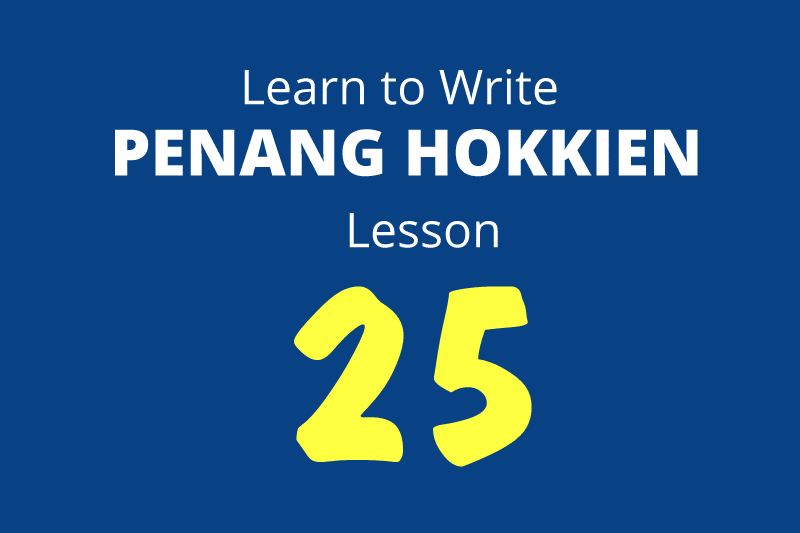
In our previous lession, we learned adjectives, which are "words that describe". In this lesson, we continue on to adverbs. These are pretty much the same as adjectives, except that, while adjectives are used to describe nouns, adverbs are used to describe other parts of speech: verbs, noun phrases, clauses, sentences, even adjectives and other adverbs.
There are two types of adverbs in Penang Hokkien: (a) words that are already adverbs in their own right, and (b) adverbs that are derived from adjectives and other adverbs.
(a) Words that are adverbs in their own right include:
- Words modifying the degree of the adjective, example: cin3cnia1 (very), khah1 (more).
Lu4 cin3cnia1 pui2.
You are very fat.
(Note that the linking verb "are" is not used in Penang Hokkien to link subjects with their description). - Words modifying verbs to indicate place, example, cit1-peng2 (here), heh1-peng2 (there).
Ie1 tua3 cit1-peng2.
He lives here.
Tan4 heh1-peng2.
Wait there. - Words modifying verbs to indicate time, for example, ba3lu1 (just), tam3ma1 (just now) and liau4 (already). Words like kin3jit1 (today), cna3hnui1 (yesterday) and even snar3 tiam4 (3 o'clock) can all be regarded as adverbs.
Wah1 ba3lu1 lai2.
I have just come.
Wah1 lai2 liau4.
I come already.
Wah1 snar3 tiam4 lai2. I came at 3 o'clock.
I came at 3 o'clock.
- Words modifying verbs to indicate certainty, for example, tnia33tiok1 (surely/certainly). For this purpose, negators such as boh2 and mm33 can also be regarded as adverbs.
Ie1 tnia33tiok1 lai2 eh2.
He will surely come.
Ie1 boh3 lai2.
He didn't come. - Some words can be adjective and adverb without changing their appearance, for example, tam3pok1 (a bit/a little).
Wah1 uh33 tam3pok3 lui1.
I have a little money.
Here, tam3pok1 serves as adjective modifying the noun lui1.
Knia2 khah1 khuai3 tam3pok1.
Go a little faster.
Here, tam3pok1 serves as adverb modifying the adjective khuai3.
When an adjective is reduplicated, it is repeated.
Examples of adverbs created through reduplication are: khuai1-khuai3
 (quickly), ban33-ban33
(quickly), ban33-ban33  (slowly), tam3pok3
-tam3pok1
(slowly), tam3pok3
-tam3pok1  (bit by bit), cun1-cun4
(bit by bit), cun1-cun4  (exactly).
(exactly).Take note that when an adjective is reduplicated, the final morpheme in the first instance is in the sandhi form, while the final morpheme in the second instance is in the citation form. For example, tam3pok3-tam3pok1.
Adverbs can be placed in front as well as behind the word they modify:
Khuai1-khuai3 lai2.

Come quickly.
Ie1 hnua33 ban33-ban33.

He drives slowly.
Wah4 cun1-cun4 snar4 tiam4 lai2.

I came at exactly 3 o'clock.
Some words appear only in reduplicated forms. They are not necessarily adverbs, for example ta33-ta33
 (every), cui33-cui33
(every), cui33-cui33  (who).
(who).Ta33-ta33 lang2 lai2 wna1-wna3.

Every person came late.
In this example, "ta33-ta33" is an adjective modifying the noun "lang2" while "wna1-wna3" is an adverb modifying the verb "lai2".
Cui3-cui3 pang1 phooi3 chao1 hiam3-hiam1?

Who released a smelly fart? (line from a popular children's nursery rhyme) In this example, "cui33-cui33" is a question word used as subject of the sentence, while "hiam3-hiam1" is the adverb modifying the adjective "chao3".
Previous Lesson | Main Page | Next Lesson
Learn Penang Hokkien with Memrise
Now you can use the most user-friendly tool on the web to learn Penang Hokkien. It helps you to listen, understand and memorise. Go to Memrise, and learn Penang Hokkien at your own pace.
Return to Penang Hokkien Resources
Latest from Discover with Timothy: Gurney Bay - what to see and do there
About this website

Hello and thanks for reading this page. My name is Timothy and my hobby is in describing places so that I can share the information with the general public. My website has become the go to site for a lot of people including students, teachers, journalists, etc. whenever they seek information on places, particularly those in Malaysia and Singapore. I have been doing this since 5 January 2003, for over twenty years already. You can read about me at Discover Timothy. By now I have compiled information on thousands of places, mostly in Peninsular Malaysia and Singapore, and I continue to add more almost every day. My goal is to describe every street in every town in Malaysia and Singapore.
Robbie's Roadmap
- Episode 1: Robbie's Journey to Financial Freedom
- Episode 2: Lost in America
- Episode 3: The Value of Money
- Episode 4: The Mentor
- Episode 5: The Thing that Makes Money
- Episode 6: The walk with a Billionaire
- Episode 7: The Financial Freedom Awakening
- Episode 8: Meet Mr Washington
- Episode 9: The Pizzeria Incident
Copyright © 2003-2024 Timothy Tye. All Rights Reserved.


 Go Back
Go Back